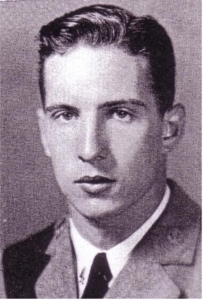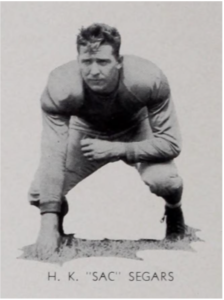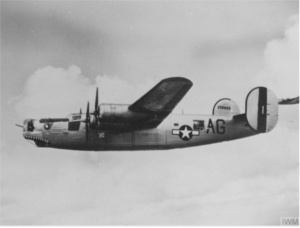Scroll of Honor – Henry Kent Segars
Squadron Commander
Written by: Kelly Durham
It was the largest airborne operation of World War II, in fact the largest in history.  Operation Market-Garden’s objective was to drop American, British, and Polish paratroopers into Holland to seize key bridges leading up to the Rhine River bridge in the Dutch city of Arnhem. Ground forces under the command of Field Marshall Montgomery were to cross the bridges and drive into Germany. It was September 1944 and Major Henry Kent Segars, accustomed to autumn action, was a squadron commander helping resupply the paratroopers until ground forces could link up with them.
Operation Market-Garden’s objective was to drop American, British, and Polish paratroopers into Holland to seize key bridges leading up to the Rhine River bridge in the Dutch city of Arnhem. Ground forces under the command of Field Marshall Montgomery were to cross the bridges and drive into Germany. It was September 1944 and Major Henry Kent Segars, accustomed to autumn action, was a squadron commander helping resupply the paratroopers until ground forces could link up with them.
Segars, a member of Clemson’s Class of 1937 from Hartsville, played many fall football games for head coach Jess Neely’s Tiger teams. His senior season, the Tigers recorded five wins and five losses, including a 19-0 Big Thursday win over South Carolina. Segars, playing at 180 pounds, was a lineman nicknamed “Sac.” Segars also ran track for the Tigers and was a member of the Block C Club. An animal husbandry major, Segars served as the commander of Company B, 1st Battalion, 1st Regiment in the Clemson ROTC Brigade.
Segars entered the Army as a second lieutenant at Fort Benning, Georgia but transferred into the Army Air Force. He earned his pilot’s wings at Kelly Field, near San Antonio, Texas in 1942. He was assigned to the 330th Bomb Squadron of the 93rd Bomb Group.
The 330th flew antisubmarine patrols above the Gulf of Mexico and the Caribbean Sea  until its deployment to the European Theater of Operations in late 1942. It was one of the initial heavy bomber squadrons assigned to the Eighth Air Force and began flying missions that autumn. In support of the Allies’ November invasion of North Africa, the squadron was transferred to IX Bomber Command and operated from airfields in Libya and Tunisia, attacking enemy targets in Italy and the southern Balkans. It also flew tactical missions against Afrika Korps defensive positions in support of the British Eighth Army’s 1943 offensive. The squadron then returned to England and resumed flying strategic bombardment missions over occupied Europe and Germany.
until its deployment to the European Theater of Operations in late 1942. It was one of the initial heavy bomber squadrons assigned to the Eighth Air Force and began flying missions that autumn. In support of the Allies’ November invasion of North Africa, the squadron was transferred to IX Bomber Command and operated from airfields in Libya and Tunisia, attacking enemy targets in Italy and the southern Balkans. It also flew tactical missions against Afrika Korps defensive positions in support of the British Eighth Army’s 1943 offensive. The squadron then returned to England and resumed flying strategic bombardment missions over occupied Europe and Germany.
By September 1944, Segars had advanced to the rank of major and was the commander of the 330th. Operation Market-Garden kicked off on September 17, but the operation was so massive that there was not sufficient airlift available to carry all of the airborne units to their drop zones in one day. On September 18, the airdrops resumed, and not just the dropping of paratroopers, but aerial resupply to airborne units dropped into action the previous day. The 330th, normally accustomed to dropping high explosive and incendiary bombs on its targets, was now pressed into service to deliver ammunition, rations, and other supplies to the lightly equipped paratroopers of the 101st Airborne Division already engaged in difficult fighting in the vicinity of Eindhoven.
Fog over east England delayed the September 18 resupply mission for several hours. Two hundred forty-eight B-24s, including aircraft from the 330th, finally launched to deliver supplies to the Allied paratroopers. Major Segars, as squadron commander, flew from the copilot’s seat of a B-24J nicknamed Sweet Chariot, piloted by Captain John Geer. Segars’s job was to lead the squadron’s mission while Geer flew the airplane. By this point in the war, the German Luftwaffe had largely been suppressed and enemy fighters were not much in evidence over Holland. But alert German ground forces were battling fiercely and anti-aircraft fire was intense. The bombers approached their resupply drop zones flying low and slow, making them easier targets for enemy gunners. Seven B-24s were shot down and six more damaged beyond repair. One hundred fifty-four out of 248 B-24s sustained damage.
 Sweet Chariot was hit by enemy ground fire and set ablaze. It was able to clear the Dutch coast, but went down in the North Sea. Eight crew members were declared missing in action, including Segars. Three others were rescued.
Sweet Chariot was hit by enemy ground fire and set ablaze. It was able to clear the Dutch coast, but went down in the North Sea. Eight crew members were declared missing in action, including Segars. Three others were rescued.
Segars, who had been overseas for nineteen months, was awarded the Distinguished Flying Cross, the Air Medal with two Oak Leaf Clusters, and the Purple Heart. He was survived by his parents and brother.
For more information about Henry Kent Segars see:
https://soh.alumni.clemson.edu/scroll/henry-kent-segars/
For additional information about Clemson University’s Scroll of Honor visit:
https://soh.alumni.clemson.edu/
The photograph of Sweet Chariot above is courtesy of the Imperial War Museum, https://www.iwm.org.uk/collections/item/object/205360859
